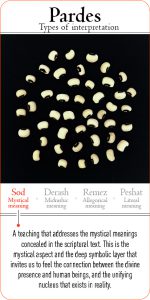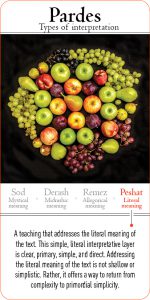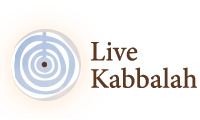Lesson 1 – Part A
The Wisdom of Kabbalah is not a belief, religion, or science. In fact, learning Kabbalah is a process of remembering knowledge already engraved on our souls, but we did not know how to connect to it, or to implement it previously. The Wisdom of Kabbalah is a combination of science, faith and the wisdom of life. The purpose of studying Kabbalah is to reach the Summit of humanities’ deepest desires – happiness, love, and peace and fulfillment.
The Wisdom of Kabbalah through the Ages and the Way it has Influenced Us
In order to understand our identity as a civilized human society, in the 21st century, no matter what our geographic location is, we must learn and understand the Wisdom of Kabbalah, as it will teach us; who we are, what our purpose in life is, what our role in society is and where we are heading as a society. The Wisdom of Kabbalah is actually the source of our desires as people of the free world. In Kabbalistic literature we will find the sources for the humanitarian principles we are proud of and for which we are ready to fight for. The principles that modern society is based on, such as; morality, values and ethics; everything is based on the Wisdom of Kabbalah.
How old is Kabbalah?
 Many see Kabbalah as the soul of Judaism; the spiritual foundations and principles behind the stories, traditions, the Bible and its precepts, the primal framework, before other characteristics of religion or history were added.
Many see Kabbalah as the soul of Judaism; the spiritual foundations and principles behind the stories, traditions, the Bible and its precepts, the primal framework, before other characteristics of religion or history were added.
Throughout history, Kabbalah was referred to as “The mother of all Wisdoms”.
There are those who believe that Kabbalah has existed since the time of Adam. However, the first time Kabbalah was introduced to mankind (according to the Kabbalists), the way we know it today, is believed to be some 4,000 years ago by Abraham the Patriarch – the first Kabbalist. The book of Genesis tells us that Abraham had passed on, “old and satiated”, which is quite a strange statement in connection with the death of a person; apparently, it implies that Abraham knew something we do not know. Abraham had probably, reached a state of “being”/spiritual completion that is unfamiliar to us today. Obviously, there’s still a lot that we can learn from Abraham today.
Supporting evidence for this argument can be found in the fact that Abraham’s character has been preserved in our collective memory for the last 4,000 years. Such honor and recognition is inconsistent with the limited amount of information that is available about Abraham and the life he led. Why was so much honor and respect reserved for Abraham? What was so special about him? Why was he so different from the other biblical figures of his day?
According to the Bible, Abraham was a kind and hospitable person who had occasional conversations with God, and yet there was something different about him. Something he did or the way in which he lived, made him familiar to almost the whole of the human race, even till today.
Who was Abraham the Patriarch?
In order to understand who Abraham was, we will try to follow his profession. Many think he was a shepherd. However, this is not accurate. In fact, only later in life, probably at around age 75, when he left the land of Haran to Canaan, did Abraham become a shepherd. Previously, Abraham was a city dweller, and according to Kabbalah, Abraham was not only the first Kabbalist but also the first Astrologer. We can find a hint that alludes to this in an ancient Midrash, which tells us “How Abraham came to know the Creator”. According to the Midrash, the young Abraham went out and saw the sun shining in the sky and thought it was responsible for everything that happens on earth, so he prayed to it. However, in the evening the sun set and the moon took its place. Abraham came to the conclusion that he was wrong and the moon is actually the ruler of the Universe, so he decided to pray to the moon and the stars instead. The next day, when the sun rose again, Abraham realized that there must be something else that rules them both. This led him to the recognition of the existence of the One Creator. According to Kabbalah, this story is part of the clue that reveals Abraham as an Astrologer, and how his gift with the stars led him to his revolutionary understanding of the structure of the Universe and the existence of the One Creator.
Later on, when Abraham worked in his father’s shop, which sold idols (a practice in direct opposition to his realization of the One Creator), the legend says that he smashed all the statues. This legend further serves to confirm the revolutionary message that Abraham was responsible for bringing into existence, the existence of the One God.
The Foundation of the Revolution that Spawned Many Revolutions
This is really a revolution in terms of the mental perceptions of the time. Abraham lived in the pagan city of Ur of the Sumerian ancient civilization. Studies of various mythologies show that the pagan way of thinking was very unpleasant. The deities of the ancients did not possess nice characters. Those deities were imbued with uncontrolled passions, ego driven, very irresponsible and unpredictable. Justice, love and compassion were not part of their everyday character traits. In fact, pagan mythology reflected a bleak worldview that was lacking hope or redemption of any kind, from a life full of pain and agony.
A very interesting study that later on became a bestselling book called, The gift of the Jews was published by Thomas Cahill – an Irish Catholic author. The study analyzed the Sumerian culture from its own texts. Cahill’s study found that the Sumerian language was missing expressions in the past and future tenses, which meant that the people of that time had a very particular way of thinking– An absolute belief that nothing could ever change for the better. This is an outlook on life, that holds that life is cyclical, and what was, will only repeat. This is a very fatalistic and pessimistic perspective of life. According to the study, Abraham the Patriarch invents a new way of thinking that did not exist before. The study says that Abraham, and later on the Hebrews, “…gave us the exterior and interior – the view of our world and our internal life… We dream Jewish dreams, hope Jewish hopes, most of our important words, such as – new, adventure, surprise, unique, individual, person, vocation, time, history, future, freedom, progress, spirit, faith, hope, justice – are the gift of the Jews” (Thomas Cahill, The Gift of the Jews). Thomas Cahill’s argument was that Abraham the Patriarch was the inventor of those words, words which had never been used before and since words have the power of creation, Abraham was responsible for creating a new world view.
What is the belief in One God? How does it relate to the Kabbalah?
 Abraham established the One God concept. Meaning, there is not One God sitting in the heavens, but that everything is one, every part of this world, each person in this world – all is one. Past, present and future, heaven and earth – all are one. We all came from One and therefore we are all connected. We may not feel this connection or we might feel like we’ve been disconnected, but it is only in our minds, and as soon as we renew this connection, or return to our situation pre-disconnection, we will be able to control everything that happens to us and around us. This is the basis for the study of Kabbalah.
Abraham established the One God concept. Meaning, there is not One God sitting in the heavens, but that everything is one, every part of this world, each person in this world – all is one. Past, present and future, heaven and earth – all are one. We all came from One and therefore we are all connected. We may not feel this connection or we might feel like we’ve been disconnected, but it is only in our minds, and as soon as we renew this connection, or return to our situation pre-disconnection, we will be able to control everything that happens to us and around us. This is the basis for the study of Kabbalah.
Abraham was responsible for the most important revolution in human consciousness of all time. From a place of total helplessness, everything is possible. Abraham’s Method, as expressed in every Kabbalah book, says that evil is an illusion and that the origin of the Creation and the world is good. Everything is an Image of God. This approach was considered to be so innovative for that time – A time when man had no rights, was treated with less than human dignity and had no control over his life.
Many years had passed before this concept became accepted in many parts of the world. However, there still exists today, in many parts of the world, where people are still struggling to achieve this revolutionary consciousness. It all started with Abraham the Patriarch.
Sefer Yetsira – The Book of Formation – The First Important Kabbalah Book
According to Jewish tradition, one of the most important books of Kabbalah is Sefer Yetsira – The Book of Formation, its writing is attributed to Abraham. This is not a religious book but a cosmology book that deals with the structure of the Universe and the forces that created the stars, the zodiac signs and actually our lives.
Although, it hasn’t been so emphasized, Hebrew Astrology has an important place in various fields of Judaism and Jewish literature, such as; the Talmud, the Zohar and Sefer Yetsira. The Zohar mentions that the Kabbalists knew the forces behind the Planets and the Signs of the Zodiac and that enabled them to rise above their influence. Meaning, the Kabbalistic understanding of Astrology, gives us the ability to control our destiny and rise above the influence of the stars. According to Kabbalah we are all blessed with Free Will and knowledge of the stars can never take that away from us.
Some of the greatest sages of Israel in the last millennium wrote commentaries on the Sefer Yetsira, among them, Rabbi Saadia Gaon (Egypt, 882/892 – Baghdad, 942), The Nahmanides (Gerona, 1194 – Israel, 1270) , The Rabad – Rabbi Avraham ben David (Provence, France, about 1125 CE – Posquières, 27 November 1198 CE), Rabbi Shabtai Donnolo (Oria, Italy, 913 – Crimea, c. 982), the Holy Ari, Rabbi Isaac Luria (Jerusalem, Israel 1534 – Safed, Israel, July 25, 1572) , The Vilna Gaon (Vilnius, Lithuania, April 23, 1720, Vilnius, Lithuania October 9, 1797) and more. All of those medieval commentators knew how important The Wisdom of Astrology was.
The Ten Commandments’ Message
While the innovative world view, described above, was actually the only inheritance of Abraham (and perhaps there were a few more like minded individuals of his time that shared his vision), the first time this vision is being bequeathed to an entire community was at Mount Sinai when the Hebrews received The Ten Utterances (known by mistake as the Ten Commandments).
According to tradition, Moses received the oral Torah on Mount Sinai. In Pirkei Avot, Mishna A, it is said that Moses received the Torah on Mount Sinai and gave it to Joshua. Not “taught”, but “gave” it to Joshua. Meaning, that Kabbalah is something beyond teaching, beyond words, or information, it is a type of consciousness, a life’s view, a long process of growth and improvement. As we acquire this state of mind we can complete our lives “old and satiated”.
According to Kabbalah, on Mount Sinai we received eternal life. The thing that bothers us most of all is death. Death, according to Kabbalah does not just relate to a physical death, it also relates to every situation where we experience an end, an end of a relationship, status, money, health, etc. The Wisdom of Kabbalah teaches that on Mount Sinai we received the cure for death, the consciousness to rise above the taste of death, and above the fear of dying. On Mount Sinai we got hope, that no matter how bad we can feel, we can always transform it, because good will always win.
This is really the message of Abraham. These principles have become the basis of modern society – The belief in every person’s right to dignity regardless of his or her religion, race, gender or economic background; A faith in the power of every person to solve his or her problems and to overcome any disabilities. All of these principles empower us to strive, fight and improve the society in which we live in and disagree with injustice and inequality. The battle still rages on and things are far from being resolved, because most people still do not understand the true essence of human freedom the way Abraham understood it. The key for that understanding is located within the Wisdom of Kabbalah.
For additional study please enter the course “Kabbalah Level 1 – The Inner World of the Kabbalist” at Live Kabbalah University.
Lesson 1
Part A
What is Kabbalah?
Part B
The Zohar through History
Part C
Kabbalah’s Influence on the Development of Modern Science
Lesson 2
Reality and Illusion, the True World (Olam HaEmet) vs. The False Reality of the bodily senses and mind.
The Language of Branches – The Special Language of the Kabbalists
The Desire and its Fulfillment
Part A
The Rules of Life
Part B
The Way to Happiness
Part C
Logic as a Barrier
Lesson 3
How did it all begin? The Creation of the Universe, The Source of all Souls, What is every Soul made of?
The Big Bang Theory vs. Rabbi Isaac Luria’s Tsimtsum Theory.
What is the source of Evil in this world? The real motivation of the soul vs. Maslow’s Hierarchy of Needs
Part A
Where do we come from?
Part B
Being a Creator
Lesson 4
Good and Evil, Good Inclination and Evil Inclination: Duality as the Source for the Meaning of Life. Free Will: Logic vs. Faith.
Lesson 5
The Tikun doctrine: How everyday’s life is a mirror of the journey the soul is taking. Why do bad things happen to Good People? The Rules of Cause and Effect, Reincarnation in Kabbalistic Teachings.
Lesson 6
Being a Creator – How to understand feelings and emotions? How can we tell between good and evil? The guidance to define negative emotions and the way to transform them.
Lesson 7
Tools for spiritual change:
- Our community.
- The Hebrew letters as an expression of hidden cosmic forces and invisible frequencies – the building blocks of our reality. The marvelous story of the 72 names of the Creator through the unofficial history of the world.
Lesson 8
Basics in Kabbalistic Meditations.
The Name of 42 Letters, The “Ana VeKho’ah” – one of the major holy metitation in the Jewish mystical world.
Lesson 9
“Ets Ha’Haim” – The Tree of Life, Sefirot and Olamot (Worlds).
How is it that The Creator never changes but it looks like He does?
The Cosmology of Good & Evil
The Tetragrammaton.
Lesson 10
The Myths of Messiah, Resurrection of the Dead and the Hebrew Calendar. Prophets of the end of days according to the Kabbalah and the ability to differ between false believes and a guidance to a better future.
To listen to the lessons above, please enter :Live Kabbalah University.
